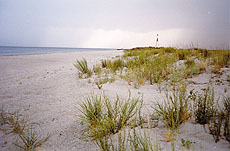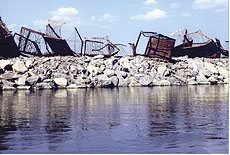 |
| The closed Vadu Plant - a public participation success story |
"The case should be mentioned in the golden book of records of public participation”, says Lucian Ionescu, executive director of Mare Nostrum, an NGO based in Constanta, the biggest Romanian city and harbour at the Black Sea.
Discovery of rare metals threatens protected area
The Chituc is situated about 25 kilometers north of Constanta, in the southern part of the Danube Delta Biosphere Reserve (DDBR). In 1993, an important 2300-hectare area in the north of the levee was declared a strictly protected area. The rest remained either a buffer or an economic zone within the DDBR. An important bird area (IBA) in Europe since 1990, the levee shelters 290 bird species, some of which are monuments of nature, such as the shelduck or the black-winged stilt. The levee is one of the last refuges in Romania for some species and an equally important feeding and rest place for others. But the levee has only recently escaped the real danger of industrial exploitation.
 |
| Stormy clouds over the Chituc marine levee - a symbol of an upcoming new threat? |
Around 1965, geologists discovered in the sands rare metals such as titanium and zirconium. Twenty years later, in 1985, exploitation of the minerals started. A floating unit excavated the sand from the levee. The sand was then transported to a primary processing plant in Vadu, in the Constanta county, just outside the boundaries of the DDBR. The resulting material was then sent for final processing to the town of Giurgiu, in the Giurgiu county. After the fall of communism, the exploitation continued at a decreasing pace till 1997 when it came to a standstill.
Exploitation allowed at experimental level
However, it only took a few years for the danger to re-emerge. Privatised under
the name of S. C. Prosidex S. A., the Vadu plant soon resumed its economic activities,
but this time under the watchful eyes of NGOs, explains Eugen Petrescu, Danube
Delta Conservation Officer and Regional Manager of the Tulcea branch of the Romanian
Ornithological Society (ROS). His society teamed up with NGOs such as Ecos, Pro-Delta,
and Mare Nostrum and together they warned the Danube Delta Biosphere Reserve Administration
(DDBRA) about the industrial activities endangering the natural balance of this
delicate part of the DDBR. As a result of their warning the DDBRA asked Prosidex
to produce an environmental impact assessment study. A first version of the study,
produced by the Bucharest-based Institute for Rare Metals, was publicly discussed
in September 2001. According to Zsolt Torok of Ecos, an NGO based in Tulcea, this
study was incomplete and therefore strongly criticised by environmentalists so
the DDBRA asked for the study to be completed. The additional assessment work
was done by the Danube Delta Development and Research National Institute (DDDRNI)
based in Tulcea. According to Janos B. Kiss, a leading scientific researcher at
the DDDRNI, the final version of the study recommended that the exploitation be
continued only at an experimental level, on a short term, and under a strict management
and environmental plan. The public participation meeting organised in February
2002 to discuss the study was stormy. More disadvantages than advantages were
outlined by environmentalists. As a result, the DDBRA took the decision to reject
the request of Prosidex. Since last year, the Chituc levee sand exploitation has
been discontinued.
 |
| Industrial rubble - a legacy of the communist past |
According to Virgil Munteanu, governor of the DDBR, "NGOs were instrumental
in this case, providing real support, helping us take the right decision”.
Adds Munteanu: "NGOs covering DDBR issues have been useful in other situations,
too, such as the recent decision of May 2003 to ban hunting across the entire
DDBR, for which we received assistance from the ROS”.
However, just saved from industrial activities, the Chituc levee faces a new danger, that of large-scale tourism. According to Ionescu, the Romanian government plans to build on that site a modern seaside resort called Europa. If approved, this project will pose a much bigger danger for the levee than the recently halted sand exploitation. For the time being, the DDBRA hasn’t received any request to grant an environmental agreement for such an investment, according to Munteanu. However, adds the governor, "I personaly don’t think such an investment is necessary on the Chituc levee. Anyway, the DDBRA is presently mapping the areas which will be open for tourist activities in the future, and the Chituc levee is certainly not among them”.